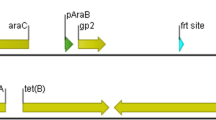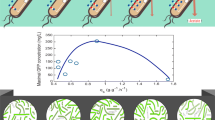Abstract
A standard fed-batch fermentation process using 1 mM isopropyl-β-d-thiogalactopyranoside (IPTG) induction at 37 °C in complex batch and feed media had been developed for manufacturing of a therapeutic protein (TP) expressed in inclusion bodies (IBs) by E. coli BL21 (DE3) driven by T7 promoter. Six unauthentic TP N-terminal variants were identified, of which methionylated TP (Met-TP) ratio was predominant. We hypothesized that lowering metabolic and protein production rates would reduce the Met-TP ratio while improving TP titer. The standard process was surprisingly auto-induced without added IPTG due to galactose in the complex media. Without changing either the clone or the batch medium, a new process was developed using lower feed rates and auto-induction at 29 °C after glucose depletion while increasing induction duration. In comparison to the standard process, the new process reduced the unauthentic Met-TP ratio from 23.6 to 9.6 %, increased the TP titer by 85 %, and the specific production yield from 210 to 330 mg TP per gram of dry cell weight. Furthermore, the TP recovery yield in the purified IBs was improved by ~20 %. Adding together, ~105 % more TP recovered in the purified IBs from per liter of fermentation broth for the new process than the standard process. The basic principles of lowering metabolic and production rates should be applicable to other recombinant protein production in IBs by fed-batch fermentations.



Similar content being viewed by others
References
Aon JC, Caimi RJ, Taylor AH, Lu Q, Oluboyede F, Dally J, Kessler MD, Kerrigan JJ, Lewis TS, Wysocki LA, Patel PS (2008) Suppressing posttranslational gluconoylation of heterologous proteins by metabolic engineering of Escherichia coli. Appl Environ Microbiol 74:950–958
Barkley MD, Riggs AD, Jobe A, Burgeois S (1975) Interaction of effecting ligands with lac repressor and repressor-operator complex. Biochemistry 14:1700–1712
Bentley WE, Davis RH, Kompala DS (1991) Dynamics of induced CAT expression in E. coli. Biotechnol Bioeng 38:749–760
Bradshaw RA, Brickey WW, Walker KW (1998) N-terminal processing: the methionine aminopeptidase and N alpha-acetyl transferase families. Trends Biochem Sci 23:263–267
Demain AL, Vaishnav P (2009) Production of recombinant proteins by microbes and higher organisms. Biotechnol Adv 27:297–306
Donovan RS, Robinson CW, Glick BR (1996) Review: optimizing inducer and culture conditions for expression of foreign proteins under the control of the lac promoter. J Ind Microbiol 16:145–154
Fahnert B, Lilie H, Neubauer P (2004) Inclusion bodies: formation and utilisation. Adv Biochem Eng Biotechnol 89:93–142
Ferrer-Miralles N, Domingo-Espin J, Corchero JL, Vazquez E, Villaverde A (2009) Microbial factories for recombinant pharmaceuticals. Microb Cell Fact 8:17
Geoghegan KF, Dixon HB, Rosner PJ, Hoth LR, Lanzetti AJ, Borzilleri KA, Marr ES, Pezzullo LH, Martin LB, LeMotte PK, McColl AS, Kamath AV, Stroh JG (1999) Spontaneous alpha-N-6-phosphogluconoylation of a “His tag” in Escherichia coli: the cause of extra mass of 258 or 178 Da in fusion proteins. Anal Biochem 267:169–184
Grossman TH, Kawasaki ES, Punreddy SR, Osburne MS (1998) Spontaneous cAMP-dependent derepression of gene expression in stationary phase plays a role in recombinant expression instability. Gene 209:95–103
Hannig G, Makrides SC (1998) Strategies for optimizing heterologous protein expression in Escherichia coli. Trends Biotechnol 16:54–60
Huang C, Lin H, Yang X (2012) Industrial production of recombinant therapeutics in Escherichia coli and its recent advancements. J Ind Microbiol Biotechnol 39:383–399
Jonasson P, Liljeqvist S, Nygren PA, Stahl S (2002) Genetic design for facilitated production and recovery of recombinant proteins in Escherichia coli. Biotechnol Appl Biochem 35:91–105
Kelley KC, Huestis KJ, Austen DA, Sanderson CT, Donoghue MA, Stickel SK, Kawasaki ES, Osburne MS (1995) Regulation of sCD4-183 gene expression from phage-T7-based vectors in Escherichia coli. Gene 156:33–36
Khalilzadeh R, Shojaosadati SA, Maghsoudi N, Mohammadian-Mosaabadi J, Mohammadi MR, Bahrami A, Maleksabet N, Nassiri-Khalilli MA, Ebrahimi M, Naderimanesh H (2004) Process development for production of recombinant human interferon-gamma expressed in Escherichia coli. J Ind Microbiol Biotechnol 31:63–69
Kleman GL, Strohl WR (1994) Developments in high cell density and high productivity microbial fermentation. Curr Opin Biotechnol 5:180–186
Liao YD, Jeng JC, Wang CF, Wang SC, Chang ST (2004) Removal of N-terminal methionine from recombinant proteins by engineered E. coli methionine aminopeptidase. Protein Sci 13:1802–1810
Makrides SC (1996) Strategies for achieving high-level expression of genes in Escherichia coli. Microbiol Rev 60:512–538
Mattanovich D, Kramer W, Luttich C, Weik R, Bayer K, Katinger H (1998) Rational design of an improved induction scheme for recombinant Escherichia coli. Biotechnol Bioeng 58:296–298
Panda AK (2003) Bioprocessing of therapeutic proteins from the inclusion bodies of Escherichia coli. Adv Biochem Eng Biotechnol 85:43–93
Panda AK, Khan RH, Rao KB, Totey SM (1999) Kinetics of inclusion body production in batch and high cell density fed-batch culture of Escherichia coli expressing ovine growth hormone. J Biotechnol 75:161–172
Sahdev S, Khattar SK, Saini KS (2008) Production of active eukaryotic proteins through bacterial expression systems: a review of the existing biotechnology strategies. Mol Cell Biochem 307:249–264
Sandman K, Grayling RA, Reeve JN (1995) Improved N-terminal processing of recombinant proteins synthesized in Escherichia coli. Bio/Technology 13:504–506
Sauvageau D, Storms Z, Cooper DG (2010) Synchronized populations of Escherichia coli using simplified self-cycling fermentation. J Biotechnol 149:67–73
Sherman F, Stewart JW, Tsunasawa S (1985) Methionine or not methionine at the beginning of a protein. BioEssays 3:27–31
Studier FW (1991) Use of bacteriophage T7 lysozyme to improve an inducible T7 expression system. J Mol Biol 219:37–44
Studier FW (2005) Protein production by auto-induction in high-density shaking cultures. Protein Expr Purif 41:207–234
Swartz JR (2001) Advances in Escherichia coli production of therapeutic proteins. Curr Opin Biotechnol 12:195–201
Walsh G (2003) Biopharmaceutical benchmarks—2003. Nat Biotechnol 21:865–870
Walsh G (2006) Biopharmaceutical benchmarks 2006. Nat Biotechnol 24:769–776
Wiltschi B, Merkel L, Budisa N (2009) Fine tuning the N-terminal residue excision with methionine analogues. ChemBioChem 10:217–220
Wu J, Chang S, Gong X, Liu D, Ma Q (2006) Identification of N-terminal acetylation of recombinant human prothymosin alpha in Escherichia coli. Biochim Biophys Acta 1760:1241–1247
Xu J, Banerjee A, Pan SH, Li ZJ (2012) Galactose can be an inducer for production of therapeutic proteins by auto-induction using E. coli BL21 strains. Protein Expr Purif 83:30–36
Yem AW, Richard KA, Staite ND, Deibel MR (1988) Resolution and biological properties of three N-terminal analogues of recombinant human interleukin-1 beta. Lymphokine Res 7:85–92
Zwickl CM, Cocke KS, Tamura RN, Holzhausen LM, Brophy GT, Bick PH, Wierda D (1991) Comparison of the immunogenicity of recombinant and pituitary human growth hormone in rhesus monkeys. Fundam Appl Toxicol 16:275–287
Acknowledgments
We would like to thank Michael Stevens and Leonard Bettinger for their help on fermentor operation, Dr. Kern Chang and John Devincentis for analytical support, Dr. Michael Borys for critical review of the manuscript, and John L. Hickey and Dr. Shu-Jen Chiang for their support on the project.
Author information
Authors and Affiliations
Corresponding author
Rights and permissions
About this article
Cite this article
Xu, J., Qian, Y., Skonezny, P.M. et al. Reduction of N-terminal methionylation while increasing titer by lowering metabolic and protein production rates in E. coli auto-induced fed-batch fermentation. J Ind Microbiol Biotechnol 39, 1199–1208 (2012). https://doi.org/10.1007/s10295-012-1127-8
Received:
Accepted:
Published:
Issue Date:
DOI: https://doi.org/10.1007/s10295-012-1127-8




